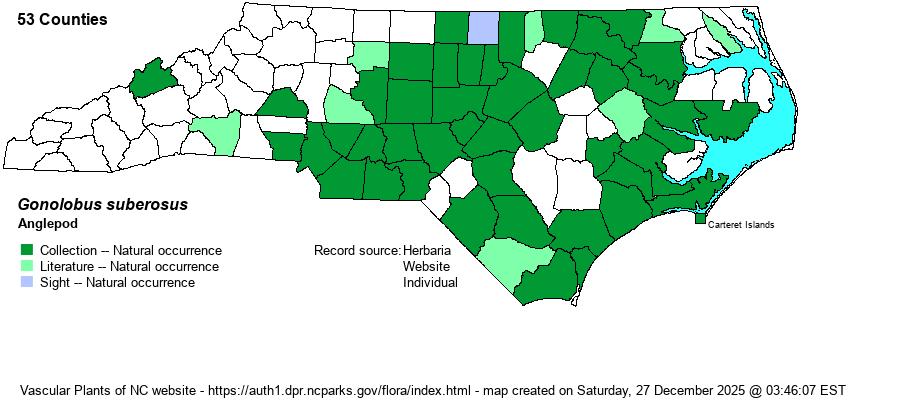| Author | (L.) R. Brown | |
| Distribution | This species is now considered to be the combined Matelea gonocarpa and M. suberosa from RAB (1968); not only has M. gonocarpa been lumped into suberosa, but in recent years the old genus name of Gonolobus has been resurrected! Collectively, the full species is now named as Gonolobus suberosus. In fact, Weakley (2018) does not consider gonocarpa as a named variety. This collective species occurs over most of the Coastal Plain and Piedmont, but is very scarce in the western Piedmont as well as the Mountains.
This species is a Southeastern one, ranging north to VA and southern MO, and south to southern FL and central TX. It is scarce in the Appalachians. | |
| Abundance | Uncommon to fairly common in the central and eastern Piedmont, as well as eastward though most of the Coastal Plain. Casual to very rare in the western third of the state, with only specimens from Madison and Catawba counties for this region. Very rare in the northeastern corner of the state. | |
| Habitat | This is a species of moist and semi-shaded places. It occurs in openings and edges of bottomland forests, wet thickets, in rich woods (but mainly in openings), and roadsides through the above habitats. |
| Phenology | Blooms from June to August, and fruits from September to November. | |
| Identification | This is a climbing and somewhat twining herbaceous vine that grows to 5-6 feet long. As with many vines, the opposite leaves are heart-shaped -- widely ovate to cordate, about 4 inches long and 3 inches wide, with a tapering tip and a somewhat cordate base. The plant has white, milky sap, a helpful character to separate it from most other vines (except Matelea species and Cynanchum laeve). As M. carolinensis can grow in identical places and have very similar leaves, you normally will need to see flowers or fruit to be certain. This species has flat, star-shaped maroon and green flowers, in small axillary clusters. The inner portions of the flowers are maroon-purple, with olive green on the outer parts of the petals. Matelea species have completely maroon to purple-brown flowers. In addition, the pods in this species are smooth, being about 5 inches long and narrow; Matelea pods are warty and thus quite rough. This species is found somewhat readily if you walk along the margins of bottomland forests, such as walking along a greenway through a floodplain forest. | |
| Taxonomic Comments | See Distribution. As Gonolobus suberosus is now a quite large species, the single variety found in NC is the nominate one -- G. suberosus var. suberosus.
| |
| Other Common Name(s) | Eastern Anglepod is the common name for the nominate variety, as it is the more easterly one. Angular Milkvine, Angular-fruit Milkvine | |
| State Rank | S5 | |
| Global Rank | G5 | |
| State Status | | |
| US Status | | |
| USACE-agcp | FACW link |
| USACE-emp | FACW link |

